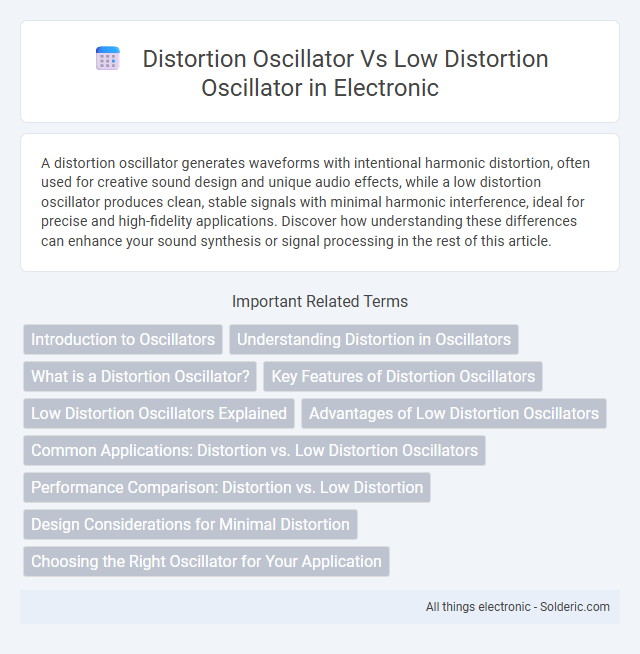A distortion oscillator generates waveforms with intentional harmonic distortion, often used for creative sound design and unique audio effects, while a low distortion oscillator produces clean, stable signals with minimal harmonic interference, ideal for precise and high-fidelity applications. Discover how understanding these differences can enhance your sound synthesis or signal processing in the rest of this article.
Comparison Table
| Feature | Distortion Oscillator | Low Distortion Oscillator |
|---|---|---|
| Signal Quality | Produces intentional waveform distortion | Maintains waveform integrity with minimal distortion |
| Output Accuracy | Lower accuracy due to added harmonic content | High accuracy with clean, stable output |
| Harmonic Content | Rich in harmonics, used for sound effects or synthesis | Minimal harmonics, ideal for precision tasks |
| Applications | Audio effects, synthesizers, creative sound design | Test equipment, communication systems, precise measurement |
| Complexity | Often simpler design focusing on distortion | More complex, designed to reduce noise and distortion |
| Cost | Generally lower due to simpler components | Higher due to precision components and design |
Introduction to Oscillators
Oscillators generate repetitive signals crucial for electronic applications, with distortion oscillators designed to produce intentional waveform alterations for effects or signal shaping. Low distortion oscillators prioritize signal purity, minimizing harmonic distortion to ensure accurate and stable frequency output essential for precision instruments and communication systems. Your choice between the two depends on whether you need modified signals or a clean, undistorted waveform.
Understanding Distortion in Oscillators
Distortion oscillators generate signals with deliberate waveform alterations, introducing harmonic content that can enrich audio textures or simulate analog warmth. Low distortion oscillators maintain signal purity by minimizing unwanted harmonic interference, crucial for precision in communication systems and accurate audio reproduction. Understanding these differences helps you select the appropriate oscillator type to optimize signal clarity or creative sound design.
What is a Distortion Oscillator?
A distortion oscillator generates sound waves with intentional signal alteration, producing harmonic or non-harmonic overtones that create a gritty or fuzzy audio effect. Low distortion oscillators prioritize signal purity, minimizing harmonic distortion to deliver clean, accurate waveforms essential for precise sound synthesis. Your choice between these oscillators impacts the timbre and clarity of the produced audio, depending on whether you prefer roughness or fidelity.
Key Features of Distortion Oscillators
Distortion oscillators generate waveforms with deliberately altered harmonics, producing gritty, edgy sounds ideal for electric guitar effects and synthesizers. Key features include adjustable waveform shaping, harmonic enhancement controls, and feedback loops to intensify signal clipping. Unlike low distortion oscillators designed for clean signals, distortion oscillators focus on texture complexity and harmonic richness.
Low Distortion Oscillators Explained
Low distortion oscillators generate clean, stable waveforms with minimal harmonic interference, ensuring precision in signal processing and measurement applications. Your circuits benefit from improved accuracy and reduced noise when using these oscillators compared to standard distortion oscillators, which often introduce unwanted signal artifacts. Understanding the design and function of low distortion oscillators helps optimize performance in high-fidelity audio, communication systems, and precision instrumentation.
Advantages of Low Distortion Oscillators
Low distortion oscillators offer superior signal purity by minimizing harmonic distortion, which enhances the accuracy and fidelity of the output waveform. These oscillators improve the performance of communication systems, test equipment, and audio devices by providing a stable and clean frequency reference. Reduced distortion also leads to lower phase noise and better overall system reliability in precision applications.
Common Applications: Distortion vs. Low Distortion Oscillators
Distortion oscillators are commonly used in audio effects and synthesizers to create rich harmonic content and warm analog tones by intentionally introducing nonlinearities. Low distortion oscillators find applications in high-fidelity audio equipment, precision measurement instruments, and communication systems where signal purity and minimal harmonic interference are critical. The choice between distortion and low distortion oscillators hinges on whether the application prioritizes creative sound shaping or accurate waveform reproduction.
Performance Comparison: Distortion vs. Low Distortion
Distortion oscillators generate richer harmonic content and pronounced waveform clipping, resulting in more aggressive audio textures, whereas low distortion oscillators maintain signal integrity with minimal harmonic interference, producing cleaner, more accurate waveforms. Performance-wise, distortion oscillators excel in applications requiring gritty, saturated sounds but suffer from increased noise and reduced waveform fidelity. Low distortion oscillators prioritize precision and stability, offering superior linearity and reduced total harmonic distortion (THD), which is critical in high-fidelity audio synthesis and measurement systems.
Design Considerations for Minimal Distortion
Design considerations for minimal distortion in oscillators emphasize selecting low-noise components and ensuring stable power supply regulation to maintain signal purity. A low distortion oscillator typically incorporates precision feedback mechanisms and careful impedance matching to reduce harmonic generation and signal clipping. Your choice of circuit topology and component quality directly impacts the oscillator's ability to deliver clean, accurate waveforms with minimal distortion artifacts.
Choosing the Right Oscillator for Your Application
Selecting the right oscillator depends on the specific requirements of your application, with distortion oscillators offering a wide range of circuit manipulation for audio effects, while low distortion oscillators prioritize signal purity essential for precision measurement and communication systems. Distortion oscillators introduce harmonic content to create desired sound alterations, making them ideal for synthesizers and guitar pedals, whereas low distortion oscillators maintain minimal harmonic distortion and phase noise to ensure accuracy and stability in RF generation and instrumentation. Understanding the trade-offs between harmonic complexity and signal fidelity is crucial when deciding between a distortion oscillator and a low distortion oscillator for optimal performance.
distortion oscillator vs low distortion oscillator Infographic

 solderic.com
solderic.com